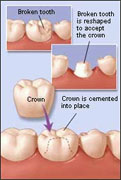A dental crown is a tooth-shaped "cap" that is placed over a tooth - covering the tooth to restore its shape and size, strength, and/or to improve its appearance. The crowns, when cemented into place, fully encase the entire visible portion of a tooth that lies at and above the gum line.
Why is a Dental Crown Needed?
A
dental crown may be needed in the following situations:

To protect a weak tooth (for instance, from decay) from breaking or to hold together parts of a cracked tooth

To restore an already broken tooth or a tooth that has been severely worn down

To cover and support a tooth with a large filling when there isn't a lot of tooth left

To hold a
dental bridge in place To cover misshaped or severely discolored teeth

To cover a
dental implant
What types of crown materials are available?
Permanent crowns can be made from all metal, porcelain-fused-to-metal, all resin, or all ceramic.
1. Metals used in crowns include gold alloy, other alloys (for example, palladium) or a base-metal alloy (for example, nickel or chromium). Compared with other crown types, less tooth structure needs to be removed with metal
crowns, and tooth wear to opposing teeth is kept to a minimum. Metal crowns withstand biting and chewing forces well and probably last the longest in terms of wear down. Also, they rarely chip or break. The metallic color is the main drawback. Metal crowns are a good choice for out-of-sight molars.
2. Porcelain-fused-to-metal dental crowns can be color matched to your adjacent teeth (unlike the metallic crowns). However, more wearing to the opposing teeth occurs with this crown type compared with metal or resin crowns. The crown's porcelain portion can also chip or break off. Next to all-ceramic crowns, porcelain-fused-to-metal crowns look most like normal teeth. However, sometimes the metal underlying the crown's porcelain can show through as a dark line, especially at the gum line and even more so if your gums recede. These crowns can be a good choice for front or back teeth.
3. All-resin dental crowns are less expensive than other crown types. However, they wear down over time and are more prone to fractures than porcelain-fused-to-metal crowns.
 top
top
4. All-ceramic or all-porcelain dental crowns provide the best natural color match than any other crown type and may be more suitable for people with metal allergies. However, they are not as strong as porcelain-fused-to-metal crowns and they wear down opposing teeth a little more than metal or resin crowns. All-ceramic crowns are a good choice for front teeth.
5. Temporary versus permanent.Temporary crowns can be made in your dentist's office whereas permanent crowns are made in a dental laboratory. Temporary crowns are made of acrylic or stainless steel and can be used as a temporary restoration until a permanent crown is constructed by the dental laboratory.
Steps Involved in Preparing a Tooth for a Crown
Preparing a tooth for a crown usually requires two dentist visits, the first step involves examining and preparing the tooth, the second visit involves placement of the permanent crown.
First Visit: Examining and preparing the tooth.
At the first visit, your dentist may take a few X-rays to check the roots of the tooth receiving the crown and surrounding bone. If the tooth has extensive decay or if there is a risk of infection or injury to the tooth's pulp, a root canal treatment may first be performed.
Before the process of making your crown is begun, your dentist will anesthetize (numb) your tooth and the gum tissue around the tooth. Next, the tooth receiving the crown is filed down along the chewing surface and sides to make room for the crown. The amount removed depends on the type of crown used (for instance, all-metal crowns are thinner, requiring less tooth structure removal than all-porcelain or porcelain-fused-to-metal ones). If, on the other hand, a large area of the tooth is missing (due to decay or damage), your dentist will use filling material to "build up" the tooth to support the crown.
After reshaping the tooth, your dentist will use impression paste or putty to make an impression of the tooth to receive the crown. Impressions of the teeth above and below the tooth to receive the dental crown will also be made to make sure that the crown will not affect your bite.
The impressions are sent to a dental laboratory where the crown will be manufactured. The crown is usually returned to your dentist's office in 2 to 3 weeks. If your crown is made of porcelain, your dentist will also select the shade that most closely matches the color of the neighboring teeth. During this first office visit your dentist will make a temporary crown to cover and protect the prepared tooth while the crown is being made. Temporary crowns usually are made of acrylic and are held in place using a temporary cement.
 |
Second Visit: Receiving the permanent dental crown.
At your second visit, your dentist will remove your temporary crown and check the fit and color of the permanent crown. If everything is acceptable, a local anesthetic will be used to numb the tooth and the new crown is permanently cemented in place.
 top
top